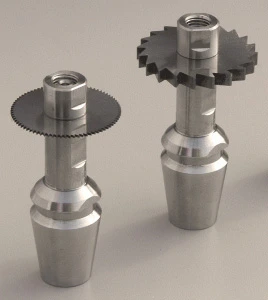Slitting Saws: What Are They?
Slitting saw, also known as slotting saw, are specialized cutting tools designed to accurately cut slots or grooves in a variety of materials. These saws come in a variety of sizes and shapes to accommodate various cutting requirements, and they are usually constructed from high-speed steel (HSS) or carbide. Slitting saws are widely used in sectors where precision and productivity are essential, such as the automotive, aerospace, and medical manufacturing industries. They can precisely cut through a variety of materials, including composites, metals, and polymers.

Principal Advantages of Slitting Saw:
For machinists and manufacturers, slitting saws provide a number of benefits:
- Increased Cutting Efficiency: Slitting saws enable the removal of material more quickly, thereby expediting the cutting process and increasing overall output.
- Superior Surface Finish: These instruments produce precise, clean cuts that often require minimal finishing.
- Versatility: They are versatile for a range of activities and can be employed for operations such as slotting, grooving, and parting off.
- Durability: Slitting saws are extremely durable due to their ability to be sharpened and turned repeatedly, which reduces the need for frequent replacement and saves money.
Slitting saws are an affordable way to make accurate slots and grooves with little downtime, whether you're cutting delicate plastics or hard metals.
HSS vs. Carbide Slitting Saws
Depending on the application, both carbide and HSS have special benefits when it comes to choosing slitting saws. Below is a breakdown of each's advantages and disadvantages:
HSS Slitting Saw Benefits:
Cost-effective: Because HSS saws are less costly, they are perfect for general-purpose cutting and projects with a smaller budget.
Versatile: They are appropriate for a wide range of cutting operations since they perform effectively on a variety of materials.
Easy to Sharpen: HSS slitting saws are simple to maintain since they are easy to re-sharpen.
HSS Slitting Saw Drawbacks:
Reduced Durability: Because HSS is less resilient than carbide, these saws may break or wear out more quickly when subjected to high loads.
Restricted for Harder Materials: Steel and titanium are two examples of harder materials for which HSS is not the best material to cut.
Reduced Cutting Speeds: In comparison to carbide, HSS saws can only manage reduced cutting speeds.
Benefits of Carbide Slitting Saws:
Extremely Durable: Carbide saws are perfect for high-performance machining tasks because they are more resilient to wear and tear.
Suitable for Hard Materials: Carbide is a good material to cut hard materials like titanium and hardened steel since it can tolerate greater cutting speeds.
Handles High Speeds: In challenging conditions, carbide slitting saws can increase productivity by operating at greater speeds.
Carbide slitting saw drawbacks
Greater Cost: Although carbide saws are more costly, their longer lifespan frequently makes the purchase worthwhile.
Difficult to Sharpen: Re-sharpening these saws can be expensive due to the need for specific tools and knowledge.
Reduced Error Tolerance: Compared to HSS, carbide tools are less tolerant of errors, requiring exact setup and alignment.
Coarse Pitch vs. Fine Pitch Slitting Saws
The distance between a slitting saw's blade teeth is known as its pitch, and it greatly affects how well the saw performs in various applications.
Coarse Pitch Slitting Saw
- Greater Teeth Spacing: Coarse pitch slitting saws are made for rough cutting and usually have 4 to 6 teeth per inch.
- Perfect for Softer Substances: Softer materials like wood, plastic, and aluminum are excellently sliced by these saws.
- Faster Material Removal: They are ideal for roughing operations because of their greater spacing, which enables faster cutting and less heat accumulation.
Fine Pitch Slitting Saw
Smaller Teeth Spacing: Smaller Teeth Spacing: With 8 to 12 teeth per inch, fine pitch slitting saws are better suited for finishing applications.
Perfect for Harder Materials: Steel, titanium, and stainless steel are among the harder materials that fine pitch saws perform well on.
Precision and Accuracy: The finer teeth are perfect for activities requiring a high level of precision because they provide smoother cuts and more accuracy.
Keep in mind that coarse pitch slitting saws provide more tooth clearance, which makes it easier to remove chips during cutting.
Conversely, fine pitch saws give greater precision but may need more regular cleaning because of the smaller gap between teeth.
Conclusion
Your material, preferred finish, and particular cutting requirements all play a significant role in selecting the best slitting saw. Carbide slitting saws provide the performance and durability required for more demanding tasks, while HSS slitting saws are a more cost-effective choice for general-purpose cutting and softer materials.
Additionally, whether you require precise finishing or rough material removal will determine which coarse-pitch or fine-pitch saw is best for you. Both kinds of saws are useful instruments for producers, providing effective, superior options for cutting grooves and slots in a variety of materials.